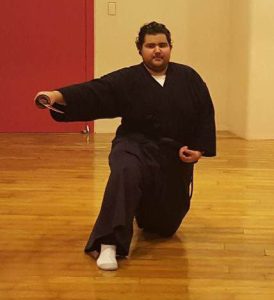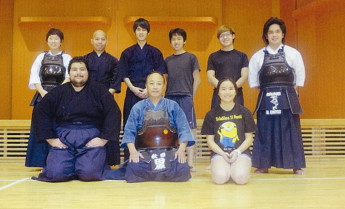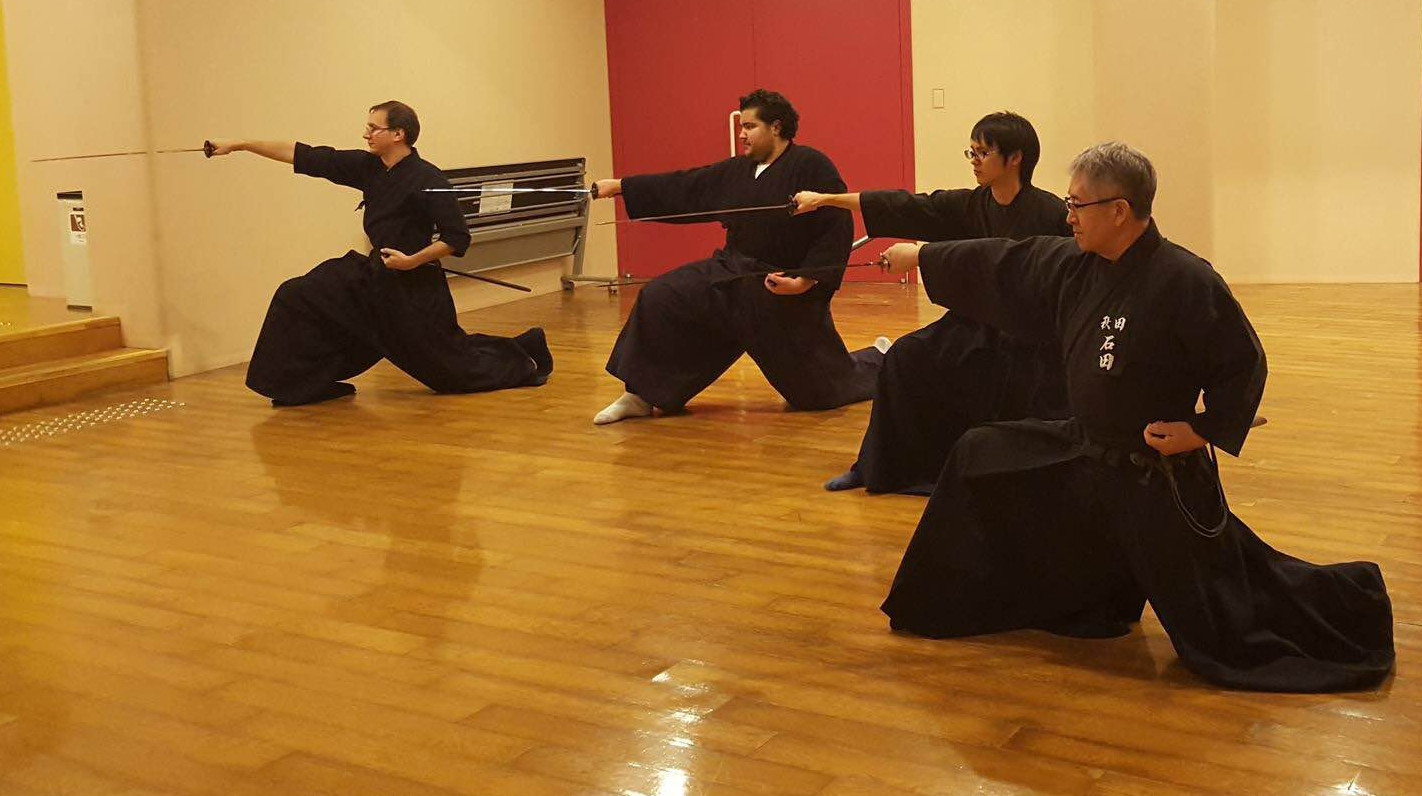AIU TOPICS
AIU Voices
Student Voice: Zachary Kingsbury, San Francisco State University, USA

Zachary at Iaido practice
Photo Courtesy of Zachary Kingsbury
Academic Experience
During my first semester, I took Political Science, Japanese 101, Tea Ceremony and Calligraphy classes. I’ve moved up to Japanese 205 for the Winter Program and I’m taking Introduction to East Asia Studies, as well.
Political Science
It was interesting to take Political Science here with students from other countries. Although it wasn’t focused on the US, it gave me the chance to look at American politics from another perspective. I tried to explain the US election system to a classmate from Taiwan, and it really made me think about the details. Since she grew up with a different system, our political structure seemed backwards to her and things that I took for granted didn’t make sense.
I think it would be interesting to take a course on US politics here, because I would love to see how it would be taught to a Japanese audience. Our political systems and attitudes to politics are so different – I’d really like to see how students would react to the comedic treatment we give our politicians, since there is nothing like that in Japan. I think I’d be able to learn a lot about Japanese politics by studying the US alongside Japanese students.
Introduction to East Asia Studies
While it’s technically a history course, we cover everything from history to economics, politics, and security. But that’s what history is – it’s the links between all of those things and how they have come to shape society. So studying it this way is much better than just memorizing a bunch of dates.
Extracurricular Activities: Clubs
I didn’t have many opportunities to participate in clubs in the US, because I was working outside of class, but here I’ve had time to join the Rock Band Club – where I learned to play bass – as well as Kendo Club and Iaido Club. I’ve made most of my friends through the clubs and that’s where I have the most chances to interact and communicate with Japanese students.
Kendo

Zachary (front left) with the Kendo Club
Photo Courtesy of Zachary Kingsbury
Iaido
I didn’t know about the Iaido Club until a friend introduced me. I joined him for one lesson – using my kendo shinai, since I didn’t have the right sword – and I was hooked.

Zachary (second from left) practicing with the Iaido Club
Photo Courtesy of Zachary Kingsbury
In both clubs, the sensei are really nice and encouraging, but they are tough on us, too. Both speak only Japanese, but we can understand one another.
In iaido, our sensei encouraged me and another international student to test for 2-kyu rank and pushed us so that we could succeed. He was really strict with us in the training, which helped when we tested. The judges at the test were serious and intimidating so I was nervous. I thought I didn’t do well, so it was a surprise when I passed.
I wanted to jump for joy, but that would not have been in character with the setting!
I plan to test again for the next rank in April, so I am working closely with my sensei through the winter, as well.
Conclusion
I have really enjoyed meeting and communicating with students from around the world here. I find that I often have to come up with new ways to explain concepts that will make sense to someone from another background. Since I want to be a teacher in the future, I enjoy the challenge!
I’ve spent a lot of time talking with Japanese students or students from other countries, and we’ve always been able to understand one another, even when our language abilities aren’t perfect. I would recommend to future students not to be too shy and self-conscious. Everybody wants to communicate and understand one another, so we are going to help each other out to make sure that works!

Zachary at Iaido practice
Photo Courtesy of Zachary Kingsbury
Academic Experience
During my first semester, I took Political Science, Japanese 101, Tea Ceremony and Calligraphy classes. I’ve moved up to Japanese 205 for the Winter Program and I’m taking Introduction to East Asia Studies, as well.
Political Science
It was interesting to take Political Science here with students from other countries. Although it wasn’t focused on the US, it gave me the chance to look at American politics from another perspective. I tried to explain the US election system to a classmate from Taiwan, and it really made me think about the details. Since she grew up with a different system, our political structure seemed backwards to her and things that I took for granted didn’t make sense.
I think it would be interesting to take a course on US politics here, because I would love to see how it would be taught to a Japanese audience. Our political systems and attitudes to politics are so different – I’d really like to see how students would react to the comedic treatment we give our politicians, since there is nothing like that in Japan. I think I’d be able to learn a lot about Japanese politics by studying the US alongside Japanese students.
Introduction to East Asia Studies
While it’s technically a history course, we cover everything from history to economics, politics, and security. But that’s what history is – it’s the links between all of those things and how they have come to shape society. So studying it this way is much better than just memorizing a bunch of dates.
Extracurricular Activities: Clubs
I didn’t have many opportunities to participate in clubs in the US, because I was working outside of class, but here I’ve had time to join the Rock Band Club – where I learned to play bass – as well as Kendo Club and Iaido Club. I’ve made most of my friends through the clubs and that’s where I have the most chances to interact and communicate with Japanese students.
Kendo

Zachary (front left) with the Kendo Club
Photo Courtesy of Zachary Kingsbury
Iaido
I didn’t know about the Iaido Club until a friend introduced me. I joined him for one lesson – using my kendo shinai, since I didn’t have the right sword – and I was hooked.

Zachary (second from left) practicing with the Iaido Club
Photo Courtesy of Zachary Kingsbury
In both clubs, the sensei are really nice and encouraging, but they are tough on us, too. Both speak only Japanese, but we can understand one another.
In iaido, our sensei encouraged me and another international student to test for 2-kyu rank and pushed us so that we could succeed. He was really strict with us in the training, which helped when we tested. The judges at the test were serious and intimidating so I was nervous. I thought I didn’t do well, so it was a surprise when I passed.
I wanted to jump for joy, but that would not have been in character with the setting!
I plan to test again for the next rank in April, so I am working closely with my sensei through the winter, as well.
Conclusion
I have really enjoyed meeting and communicating with students from around the world here. I find that I often have to come up with new ways to explain concepts that will make sense to someone from another background. Since I want to be a teacher in the future, I enjoy the challenge!
I’ve spent a lot of time talking with Japanese students or students from other countries, and we’ve always been able to understand one another, even when our language abilities aren’t perfect. I would recommend to future students not to be too shy and self-conscious. Everybody wants to communicate and understand one another, so we are going to help each other out to make sure that works!
